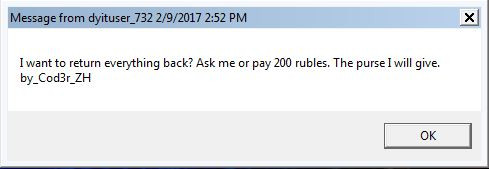RANSOM_RARLOCK.F116KA
BAT/LockFiles.C!tr (Fortinet), Ransom:Win32/Blobash.A (Microsoft)
Windows


Threat Type: Trojan
Destructiveness: No
Encrypted: No
In the wild: Yes
OVERVIEW
This Trojan arrives on a system as a file dropped by other malware or as a file downloaded unknowingly by users when visiting malicious sites.
It is capable of encrypting files in the affected system.
TECHNICAL DETAILS
Arrival Details
This Trojan arrives on a system as a file dropped by other malware or as a file downloaded unknowingly by users when visiting malicious sites.
Installation
This Trojan drops and executes the following files:
- %User Temp%\{random characters}.tmp\Cod3r_ZH.bat - deletes itself after execution
(Note: %User Temp% is the user's temporary folder, where it usually is C:\Documents and Settings\{user name}\Local Settings\Temp on Windows 2000, Windows Server 2003, and Windows XP (32- and 64-bit); C:\Users\{user name}\AppData\Local\Temp on Windows Vista (32- and 64-bit), Windows 7 (32- and 64-bit), Windows 8 (32- and 64-bit), Windows 8.1 (32- and 64-bit), Windows Server 2008, and Windows Server 2012.)
Dropping Routine
This Trojan drops the following files:
- {malware path}\{4 random characters}\info.txt - contains text in messagebox
- {malware path}\{4 random characters}\CH.txt
- {malware path}\LOCK.rar - contains encrypted files
Other Details
This Trojan does the following:
- It uses WinRAR.exe to encrypt the files using the following command:
- "%Program Files%\WinRAR\Rar.exe" a -r -y -ri15 -df -m0 -inul -p"{password}" "LOCK.rar"
- The parameters meaning the following:
- a - add files to archive
- r - recurse subdirectories
- y - assume Yes on all queries
- df - delete files after archiving
- m0 - set compression level to 0
- inul - Disable all messages
- p- set password
(Note: %Program Files% is the Program Files folder, where it usually is C:\Program Files on all Windows operating system versions; C:\Program Files (x86) for 32-bit applications running on Windows 64-bit operating systems.)
It is capable of encrypting files in the affected system.
NOTES:
Based on the analysis of codes, it has other capabilities than was not exhibited due to the batch file deleting itself.
It uses "118095" as the password. The ransomware displays the following ransomnote:

SOLUTION
Step 1
Before doing any scans, Windows XP, Windows Vista, and Windows 7 users must disable System Restore to allow full scanning of their computers.
Step 2
Note that not all files, folders, and registry keys and entries are installed on your computer during this malware's/spyware's/grayware's execution. This may be due to incomplete installation or other operating system conditions. If you do not find the same files/folders/registry information, please proceed to the next step.
Step 3
Search and delete this file
- %User Temp%\{4 random characters}.tmp\Cod3r_ZH.bat
- {malware path}\{4 random characters}\info.txt
- {malware path}\{4 random characters}\CH.txt
Step 4
Scan your computer with your Trend Micro product to delete files detected as RANSOM_RARLOCK.F116KA. If the detected files have already been cleaned, deleted, or quarantined by your Trend Micro product, no further step is required. You may opt to simply delete the quarantined files. Please check this Knowledge Base page for more information.
Step 5
Restore encrypted files from backup.
Did this description help? Tell us how we did.

